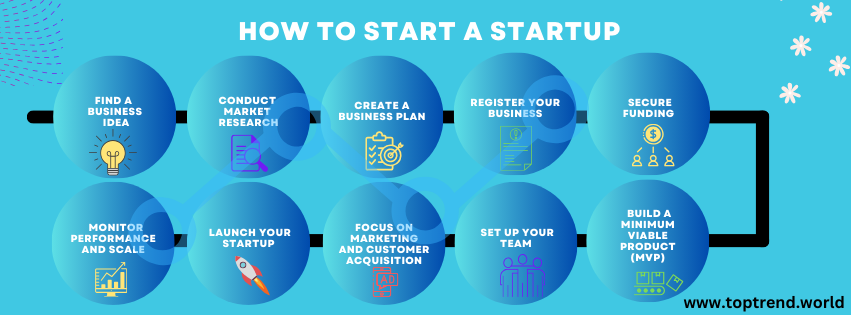The Journey from Idea to Startup: A Step-by-Step Guide
In today’s rapidly evolving business landscape, many individuals dream of launching their own startups. Start Your Own Startups is an exciting journey,
For start your own startups it requires careful planning, resilience, and dedication. Whether you’re driven by passion, the desire to solve a problem, or simply seeking to create financial independence, this guide will walk you through the essential steps to starting a successful startup.
schemes and policies in in india for statupus
The Ultimate Blueprint for Starting a Startup in 2024

How to Start Your Own Startups: A Step-by-Step Guide
1. Find Good Business Idea
First step for start your own startups is find good business idea

Every great startup begins with a solid idea. The key is to focus on solving a real-world problem that resonates with a specific target audience. Here’s how you can generate and refine a business idea
- Identify a Problem: What challenges do you, or others, face in daily life? Successful startups often arise from identifying pain points that have not been adequately addressed by existing solutions.
- Leverage Your Passion and Skills: Your startup will demand a lot of your time and energy, so it’s crucial to choose something you are passionate about. Align the idea with your skills to ensure you can execute it effectively.
Innovative Business Ideas to Start in 2024

2. Conduct Market Research
Second step for start your own startups is conduct market research

Before diving in, it’s critical to validate your idea through market research. This helps ensure that there’s genuine demand for your product or service.
- Validate the Idea: Conduct surveys, interviews, or even launch a simple landing page to gauge interest. You can use tools like Google Trends or conduct focus groups to gather early feedback.
- Competitor Analysis: Study your competition to understand their offerings, strengths, and weaknesses. This helps you pinpoint how you can differentiate your startup and offer better value.
3. Create a Business Plan
Third step for start your own startups is create a business plan
A well-structured business plan acts as a roadmap for your startup. It outlines your goals, strategies, and the steps you’ll take to achieve them.
- Executive Summary: Write a concise overview of your business idea, mission, and vision.
- Business Model: How will your startup generate revenue? Will it be subscription-based, ad-supported, or rely on direct sales?
- Target Audience: Define who your customers will be and tailor your marketing strategy accordingly.
- Financial Projections: Outline your projected costs, revenue streams, and break-even point. This will also be useful when seeking investors.
4. Register Your Business
Fourth step for start your own startups is register your business
Once your idea is refined, it’s time to make it official by registering your startup and fulfilling any legal requirements.
- Choose a Legal Structure: Options include sole proprietorship, partnership, limited liability company (LLC), or corporation. Each has different implications for taxes and liability.
- Register Your Business Name: Ensure your chosen name is unique and available for use. You can check through government databases or online registries.
- Obtain Necessary Permits: Depending on your industry, you may need to apply for specific licenses or permits before operating.
5. Secure Funding
Fifth Step for start your own startups is secure funding
One of the biggest challenges for startups is funding. There are various ways to raise capital, depending on the stage of your business.
- Bootstrapping: Many entrepreneurs start by using their personal savings to fund the initial stages.
- Friends and Family: If you have a supportive network, you can approach friends and family for early-stage investments.
- Venture Capital or Angel Investors: For more significant funding, pitch your idea to venture capitalists or angel investors who specialize in startups.
- Crowdfunding: Platforms like Kickstarter and Indiegogo can help you raise funds from a large group of people who believe in your idea.
- Small Business Loans and Grants: Research government programs that offer loans or grants for startups in specific industries.
6. Build a Minimum Viable Product (MVP)
Sixth step for start your own startups is build a minimum viable product (MVP)
Creating an MVP is a crucial step in refining your product idea before fully launching.
- Prototype Your Idea: The MVP is a stripped-down version of your product that solves the core problem. It allows you to test with real users and get feedback.
- Iterate Based on Feedback: Use feedback to improve your product until you’re confident that it meets market demands.
7. Set up Your Team
seventh step for start your own startups is set up your team
Your startup’s success depends heavily on the people behind it. Build a core team that complements your strengths and covers areas where you may lack expertise.
- Co-Founders: Consider finding co-founders with complementary skills. For instance, if you’re tech-savvy but not a marketer, find someone with marketing expertise.
- Hiring Key Roles: Initially, you may only need a small team, but hire for critical roles like product development, marketing, and customer support.
- Outsourcing: If you can’t afford to hire full-time employees, consider outsourcing tasks like design, development, or accounting to freelancers.
8. Focus on Marketing and Customer Acquisition
Eight step for start your own startups is Focus on Marketing and Customer Acquisition

Without customers, even the best product will fail. Early marketing efforts are crucial to attract attention and build momentum.
- Build a Website: Your website is the face of your startup. Ensure it’s professional, user-friendly, and optimized for search engines (SEO).
- Social Media Marketing: Establish your presence on platforms where your target audience spends time, whether it’s Instagram, LinkedIn, or YouTube.
- Networking: Attend industry events, startup meetups, and connect with potential customers and partners through networking opportunities.
9. launch your startup
Nine step for start your own startups is launch your startup
When your MVP is ready, it’s time to launch. You can choose a soft or full launch depending on the stage of product development.
- Soft Launch: This involves releasing your product to a smaller, controlled group of users to test functionality and gather feedback.
- Full Launch: Announce your startup to the public through press releases, social media campaigns, or product launches on platforms like Product Hunt.
10. Monitor Performance and Scale
Last step for start your own startups is monitor performance and scale
After launching, your focus should shift to refining your business model and scaling your operations.
- Track KPIs: Keep an eye on key performance indicators (KPIs) such as user growth, customer acquisition cost (CAC), and revenue. This will help you identify areas for improvement.
- Adapt to Feedback: Be prepared to pivot or adjust your strategy based on customer feedback or changes in market conditions.
- Scale the Business: Once you have a steady customer base, look for opportunities to expand. This could involve adding new features, entering new markets, or scaling operations.
Final Thoughts
Starting a startup is both exciting and challenging, but with the right mindset, preparation, and strategy, you can turn your idea into a successful business.
Remember to stay flexible, continuously learn from feedback, and focus on creating value for your customers. Whether you’re launching a tech company, an e-commerce store, or a service-based business, the steps outlined above will help you build a solid foundation for success.




One thought on “How to Start Your Own Startups :From Idea to Reality”